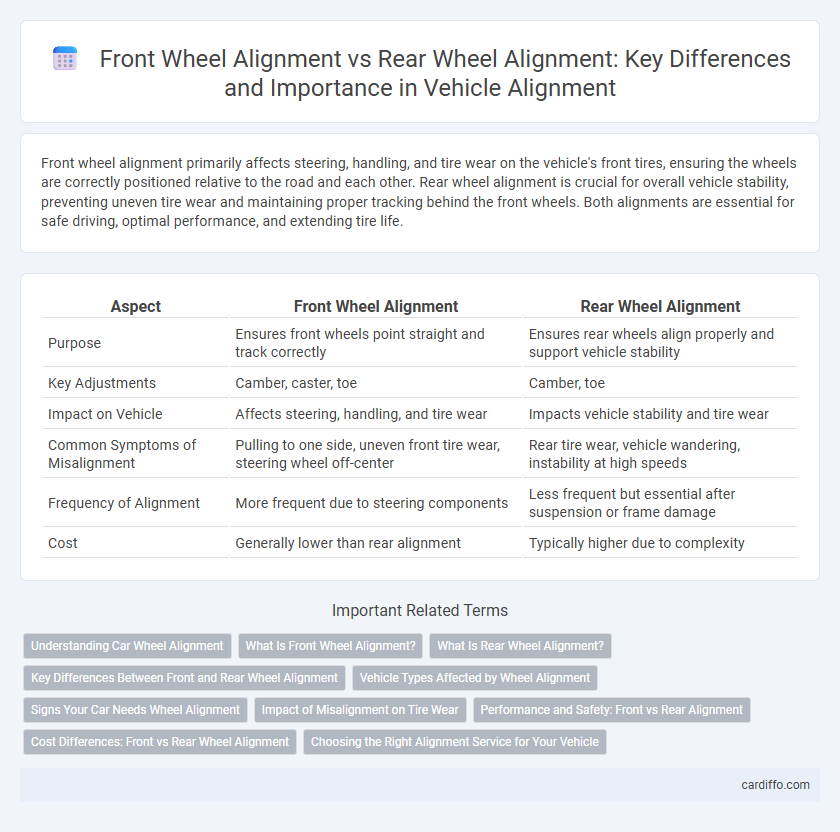Front wheel alignment primarily affects steering, handling, and tire wear on the vehicle's front tires, ensuring the wheels are correctly positioned relative to the road and each other. Rear wheel alignment is crucial for overall vehicle stability, preventing uneven tire wear and maintaining proper tracking behind the front wheels. Both alignments are essential for safe driving, optimal performance, and extending tire life.
Table of Comparison
| Aspect | Front Wheel Alignment | Rear Wheel Alignment |
|---|---|---|
| Purpose | Ensures front wheels point straight and track correctly | Ensures rear wheels align properly and support vehicle stability |
| Key Adjustments | Camber, caster, toe | Camber, toe |
| Impact on Vehicle | Affects steering, handling, and tire wear | Impacts vehicle stability and tire wear |
| Common Symptoms of Misalignment | Pulling to one side, uneven front tire wear, steering wheel off-center | Rear tire wear, vehicle wandering, instability at high speeds |
| Frequency of Alignment | More frequent due to steering components | Less frequent but essential after suspension or frame damage |
| Cost | Generally lower than rear alignment | Typically higher due to complexity |
Understanding Car Wheel Alignment
Front wheel alignment primarily affects steering control and tire wear, ensuring the front wheels point straight and maintain proper camber, caster, and toe angles for optimal handling. Rear wheel alignment stabilizes the vehicle's balance and overall driving dynamics by aligning the rear wheels to prevent uneven tire wear and improve fuel efficiency. Understanding the differences between front and rear wheel alignment is crucial for maintaining vehicle safety, extending tire life, and enhancing ride comfort.
What Is Front Wheel Alignment?
Front wheel alignment involves adjusting the angles of the front wheels to the manufacturer's specifications to ensure proper steering, tire wear, and vehicle handling. Key parameters adjusted during front wheel alignment include camber, caster, and toe, which directly influence vehicle stability and responsiveness. Proper front wheel alignment helps maintain optimal contact between tires and the road, improving safety and fuel efficiency.
What Is Rear Wheel Alignment?
Rear wheel alignment involves adjusting the angles of the rear wheels to ensure they are parallel to each other and perpendicular to the road surface, enhancing vehicle stability and tire longevity. Unlike front wheel alignment which primarily affects steering and handling, rear wheel alignment focuses on maintaining proper tracking and preventing uneven tire wear. Proper rear wheel alignment also improves overall vehicle safety by maintaining correct suspension geometry.
Key Differences Between Front and Rear Wheel Alignment
Front wheel alignment primarily adjusts the camber, caster, and toe angles to ensure proper handling, steering response, and tire wear, while rear wheel alignment mainly focuses on the toe angle to maintain vehicle stability and tracking. Front alignment is critical for accurate steering control and responsiveness, whereas rear alignment ensures that the vehicle follows a straight path and prevents tire scrubbing or uneven rear tire wear. Misalignment in the front wheels often results in noticeable steering issues, whereas rear misalignment usually affects overall stability and can cause subtle handling problems.
Vehicle Types Affected by Wheel Alignment
Front wheel alignment primarily affects front-wheel-drive vehicles, where precise adjustment is critical for steering control and tire wear prevention. Rear wheel alignment is more crucial for rear-wheel-drive and all-wheel-drive vehicles, ensuring stability and balanced traction. Both alignments are essential for trucks and SUVs due to heavier loads and off-road conditions impacting wheel positioning.
Signs Your Car Needs Wheel Alignment
Uneven tire wear, steering wheel vibration, and the vehicle pulling to one side are common signs your car needs front or rear wheel alignment. Front wheel misalignment often results in more noticeable steering issues and uneven tread wear on the front tires, while rear wheel misalignment can cause instability and uneven wear on the rear tires. Regular wheel alignment checks improve tire lifespan, fuel efficiency, and overall vehicle safety.
Impact of Misalignment on Tire Wear
Front wheel alignment primarily affects steering control and causes uneven tire wear, especially on the inner or outer edges of the front tires. Rear wheel alignment influences vehicle stability and can lead to irregular wear patterns across the rear tires, reducing overall tire lifespan. Misalignment in either front or rear wheels accelerates tire degradation, compromises safety, and increases fuel consumption.
Performance and Safety: Front vs Rear Alignment
Front wheel alignment primarily affects steering precision, tire wear, and vehicle handling, making it critical for optimal performance and safety during cornering and braking. Rear wheel alignment contributes to overall stability, maintaining proper vehicle balance and preventing uneven tire wear, which enhances long-term safety and ride comfort. Proper alignment of both front and rear wheels ensures consistent traction, improved fuel efficiency, and reduces the risk of accidents caused by poor handling or tire failure.
Cost Differences: Front vs Rear Wheel Alignment
Front wheel alignment typically costs between $50 and $100, while rear wheel alignment ranges from $75 to $150 due to the additional complexity and equipment required. The higher price for rear wheel alignment reflects the need for precise adjustments affecting vehicle stability and tire wear on both axles. Understanding these cost differences helps in budgeting for comprehensive alignment services that ensure optimal driving performance.
Choosing the Right Alignment Service for Your Vehicle
Front wheel alignment adjusts the angles of the front wheels to improve steering response and tire wear, ideal for vehicles with front-wheel drive or steering issues. Rear wheel alignment focuses on the rear wheels, critical for maintaining vehicle stability and proper handling in all-wheel or rear-wheel drive cars. Selecting the appropriate alignment service depends on your vehicle's drivetrain, tire wear patterns, and suspension design to ensure optimal performance and safety.
Front Wheel Alignment vs Rear Wheel Alignment Infographic

 cardiffo.com
cardiffo.com